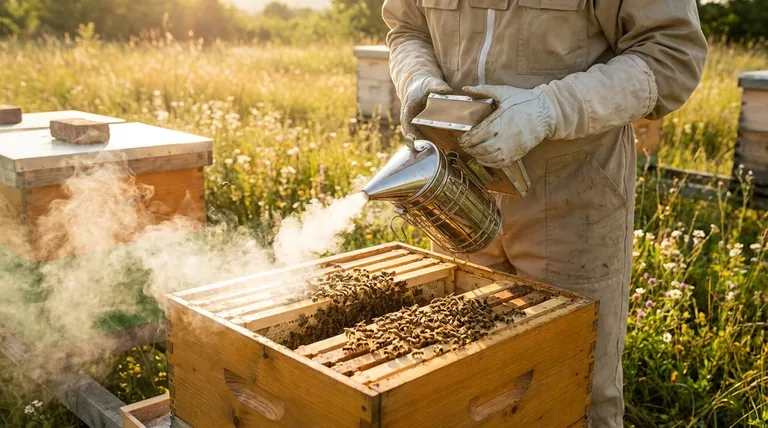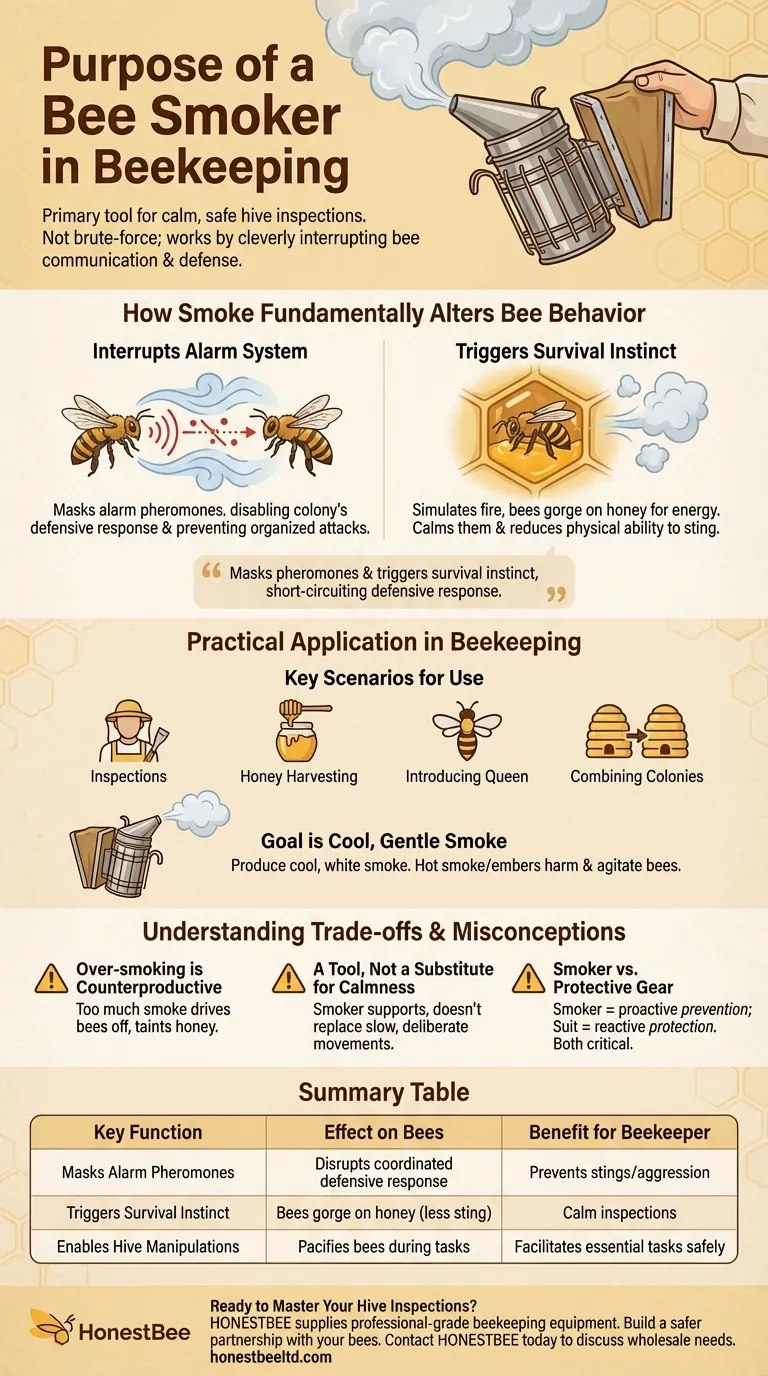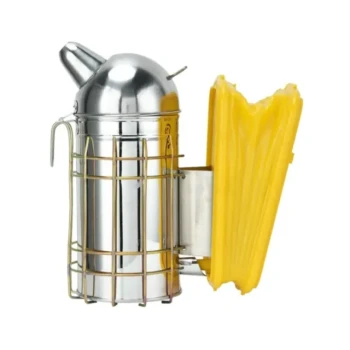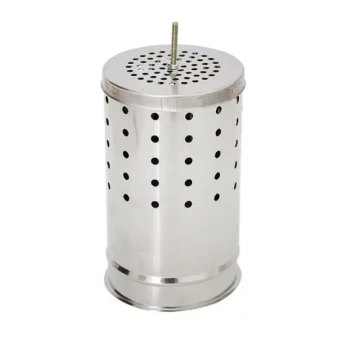A bee smoker is the beekeeper's primary tool for ensuring a calm and safe hive inspection. It is a small, handheld device that generates cool smoke, which is gently puffed into and around the hive. The purpose of this smoke is to pacify the bees, making them less defensive and significantly reducing the likelihood of stings for the beekeeper.
The bee smoker is not a brute-force tool; it works by cleverly interrupting the bees' primary methods of communication and defense. It masks their chemical alarm signals while simultaneously triggering a natural survival instinct, effectively short-circuiting their organized defensive response.

How Smoke Fundamentally Alters Bee Behavior
To use a smoker effectively, it's crucial to understand the two distinct ways it influences a honeybee colony. It's a sophisticated manipulation of their innate biology.
Interrupting the Alarm System
Honeybees use chemical signals called pheromones to communicate. When a guard bee perceives a threat, it releases an alarm pheromone that alerts other bees and directs them to attack the intruder.
This signal is the catalyst for a coordinated defensive response. The smoke from your smoker masks or overwhelms these pheromones, effectively disabling the colony's alarm system. If other bees cannot detect the signal, the chain reaction of aggression is prevented before it can start.
Triggering a Survival Instinct
The presence of smoke triggers a deep, evolutionary response in honeybees: the threat of a forest fire. Their immediate instinct is to prepare to abandon the hive.
To do this, the bees rush to open honey cells and begin gorging on honey, loading up on energy reserves for a potential journey. This has two calming effects: it preoccupies them with a task other than defense, and a bee with a full stomach is physically less able to flex its abdomen to sting effectively.
The Practical Application in Beekeeping
A smoker is not used indiscriminately. It is a tool for specific, necessary interactions that would otherwise be highly stressful for both the beekeeper and the bees.
Key Scenarios for Smoker Use
A smoker is essential during any major hive manipulation. This includes routine health inspections, honey harvesting, introducing a new queen, or combining two separate colonies. In each case, you are disrupting the natural order of the hive, and the smoker makes this process manageable.
The Goal is Cool, Gentle Smoke
The objective is to produce puffs of cool, white smoke. Hot smoke or embers can harm the bees and make them more agitated. Proper use involves a few gentle puffs at the hive entrance before opening, followed by a few more across the top of the frames once the lid is removed.
Understanding the Trade-offs and Misconceptions
While indispensable, a smoker is a powerful tool that requires judgment. More is not always better, and it doesn't replace the need for skill and care.
Over-smoking is Counterproductive
Using too much smoke can be detrimental. It can drive bees off the comb, making it difficult to inspect the brood or find the queen. Excessive smoke can also taint the flavor of honey and cause unnecessary stress to the colony.
A Tool, Not a Substitute for Calmness
The smoker is designed to manage a colony's defensive response, but it does not give the beekeeper a license to be rough or careless. Your first line of defense is always slow, deliberate movement. The smoker supports your calm actions; it cannot replace them.
Smoker vs. Protective Gear
Some say the smoker is more important than a bee suit, and there is wisdom in this. The smoker is a proactive tool that prevents an attack, while a bee suit is a reactive tool that protects you during one. Both are critical components of a complete safety system.
Making the Right Choice for Your Goal
Integrating the smoker into your beekeeping practice is about understanding your intent for every hive interaction.
- If your primary focus is safety and building confidence: Treat the smoker as your most important piece of equipment. Learn to light it properly and use it consistently every time you open a hive.
- If your primary focus is colony health and productivity: Use smoke judiciously to perform efficient inspections with minimal stress, allowing the bees to return to their work as quickly as possible.
- If you are managing a particularly defensive hive: The smoker is your non-negotiable partner, allowing you to safely perform essential tasks without escalating the bees' aggression or endangering yourself.
Mastering the smoker is the first step toward a calm, confident, and productive partnership with your bees.
Summary Table:
| Key Function | Effect on Bees | Benefit for Beekeeper |
|---|---|---|
| Masks Alarm Pheromones | Disrupts coordinated defensive response | Prevents stings and aggressive behavior |
| Triggers Survival Instinct | Bees gorge on honey, reducing ability to sting | Allows for calm, uninterrupted hive inspections |
| Enables Hive Manipulations | Pacifies bees during inspections, honey harvesting, etc. | Facilitates essential beekeeping tasks safely |
Ready to Master Your Hive Inspections?
A reliable bee smoker is the cornerstone of safe and productive beekeeping. For commercial apiaries and equipment distributors, having access to high-quality, durable beekeeping supplies is non-negotiable.
HONESTBEE supplies professional-grade beekeeping equipment through wholesale-focused operations, ensuring you have the tools for success. Let us help you build a safer, more efficient partnership with your bees.
Contact HONESTBEE today to discuss your wholesale supply needs and elevate your beekeeping operation.
Visual Guide

Related Products
- Stainless Steel Honey Bee Smoker Hive and Honeycomb Smoker for Beekeeping
- Economy Galvanized Beekeeping Honey Bee Smoker for Wholesale
- Premium Traditional Copper Bee Smoker with Bellows
- Professional Bee Smoker with Elongated Spout and Durable Bellows for Beekeeping
- European Stainless Steel Bee Smoker for Honey Bee Hive
People Also Ask
- How did early beekeepers use bee smokers? Master Ancient Bee Calming Techniques
- What is the purpose of a bee smoker and how should it be used? A Guide to Calm, Safe Hive Inspections
- What is the smoke that beekeepers use? The Secret to Safe and Calm Hive Inspections
- What is a bee smoker and what is its primary purpose? Master Safe Hive Inspections
- What is the proper technique for lighting a bee smoker? Master the Layered Fire Method for Calm Hives



















